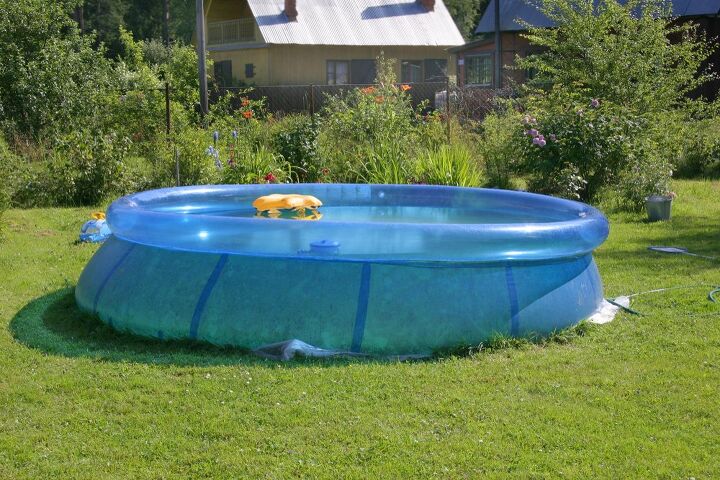How To Level A Pool That Is Already Filled (Quickly & Easily!)

Summer is here, and you’re ecstatic because your new pool is ready to use. Then you notice that one side of the pool has more water than the other. This indicates that the ground beneath your pool isn’t precisely level. You will need to re-level your pool since it’s hazardous to swim in it under these conditions. But how do you do it without draining it?
You can level your pool while it is full by emptying your pool down to half full and removing the leveling blocks. Raise the pool wall and then replacing the leveling blocks. Repeat on all sides. Pack the holes, and fill your pool. Emptying a little is necessary to take the extra weight off.
If you find yourself in this situation, don’t worry! We have the best solution for you. Re-leveling a pool can be time-consuming, especially if you have to empty it before proceeding fully. Below we’ve included the step for you to re-level your pool without fully emptying it to keep this easy and convenient for you.
Do You a Need Pool, Spa, or Hot Tub Contractor?
Get free, zero-commitment quotes from pro contractors near you.

How Unlevel Is Your Pool?
First, it’s important to figure out how unlevel your pool is. Figuring out how lopsided the pool is will give you an idea of just how much you’re going to need to raise it.
One Inch Or Less
For above-ground pools, level ground is required. The water level will be higher on that side if one side is an inch lower than the other.
Any roughhousing or jumping into the water will cause water to splash out. That isn’t a big concern, but you’ll have to add water regularly, which will wear down the sidewall over time.
Two Inches Or More
It becomes a major issue if the two sides are two inches or more apart. Water will always remain level no matter what you do with it; thus, a two-inch differential puts a lot of water pressure against the bottom side’s wall.
The walls are designed to sustain the weight of the water uniformly. When one side of the body carries more weight than the other, it will begin to bulge. The wall will fall if it is left that way. The speed at which this occurs is determined by the amount of water in your pool. Hours, days, or weeks could pass.
Fix Your Unlevel Pool While Full
It’s tough to level a pool after it’s been filled with water. Some will tell you that you must empty the pool, disassemble it, and restart from the beginning.
This is why we emphasize the importance of preparing the ground with the proper tools and double- and triple-checking its level before installing the pool for the first time.
Please Have A Helper
There is a way. It’s a difficult task that will require at least two individuals to complete. Remember that your goal with this task is to get the majority of the weight off one side and evenly distributed throughout. It’s impossible to get a pool completely level with the water in it, so do the best you can.
Because you’ll be working with tough materials, we recommend that you put on a pair of work gloves to protect your hands. They will also improve your grip.
Tools You Will Need
- Hose
- Shovel
- Work gloves
- Filler
- Water level
- Hammer or rubber mallet
Instructions
Step 1: Drain A Little Bit Of Water
Because you’ll be lifting the lower half of the pool, you’ll need to shed some pounds. We suggest draining the pool till it’s only half-filled. this is especially important if you need to raise the pool one inch or more.
If you don’t shed the extra weight, you run the risk of significant injury or possibly even damaging your pool. Then, you won’t be able to swim or have anything to swim in. While you may not want to drain the pool, you will need to just down to the halfway mark.
Step 2: Remove the leveling blocks
Leveling blocks were placed beneath the slab when the pool was installed. You’ll want to take them off the bottom. Make sure you only do this to one section at a time, as you don’t want to remove all of them at the same time, or you won’t be able to wedge them back underneath without draining the pool entirely.
Step 3: Raise The Pool Wall
After you’ve removed the blocks, lift the slab, place the tip under the slab’s lip and push the handle down. Check to see that the edge is level with the rest by using a level. You can set a piece of plywood across the top of your pool and put the level on it to check.
Step 4: Replace The Leveling Blocks
Replace the leveling blocks underneath the slab while you’re holding it up. They’ll be difficult to get into, so a hammer will come in handy. Make sure you wedge it in there nice and good. You can use a rubber mallet to whack it into place.
Step 5: Repeat Steps 2 Through 4
This procedure must be repeated for each set of leveling blocks on the foundation’s lower side. It’s best to do two leveling blocks at a time but no more than that so that you keep the pool from sloping even more, especially with that much water sitting in it.
Step 6: Fill The Hole And Pack It
You should be able to see a hole where you raised it. Fill it up with dirt. Using a hose, wet it down to make sure it’s all packed in. The pool will shift if it isn’t packed tightly enough, and you’ll have to start over.
If you feel more comfortable, you can always turn this into a multi-day job if you feel like placing concrete in the holes instead of dirt so that your foundation doesn’t shift.
Step 7: Refill The Pool With Fresh Water
Fill the pool with water to the appropriate level, but only after checking to ensure the pool was completely level. That way, you’re not stuck emptying it again and repeating the process all over.
Do You a Need Pool, Spa, or Hot Tub Contractor?
Get free, zero-commitment quotes from pro contractors near you.

Wrapping It Up
We cannot emphasize enough how critical it is to ensure that your ground is properly level before installing your pool. It can be time-consuming and difficult, but it’s a lot easier when there’s no weight on it.
Things don’t always go as planned, so don’t be discouraged if your pool is uneven after you fill it. It can be fixed. All it takes is a lot of effort and desire on your behalf. When you’re finished, take a well-earned break. Fill the pool with water and relax!

Heather is a passionate writer who loves anything DIY. Growing up, she learned everything from home repairs to design, and wants to share her tips with you. When she's not writing, she's usually hiking or searching for her next DIY project.
More by Heather Robbins



























